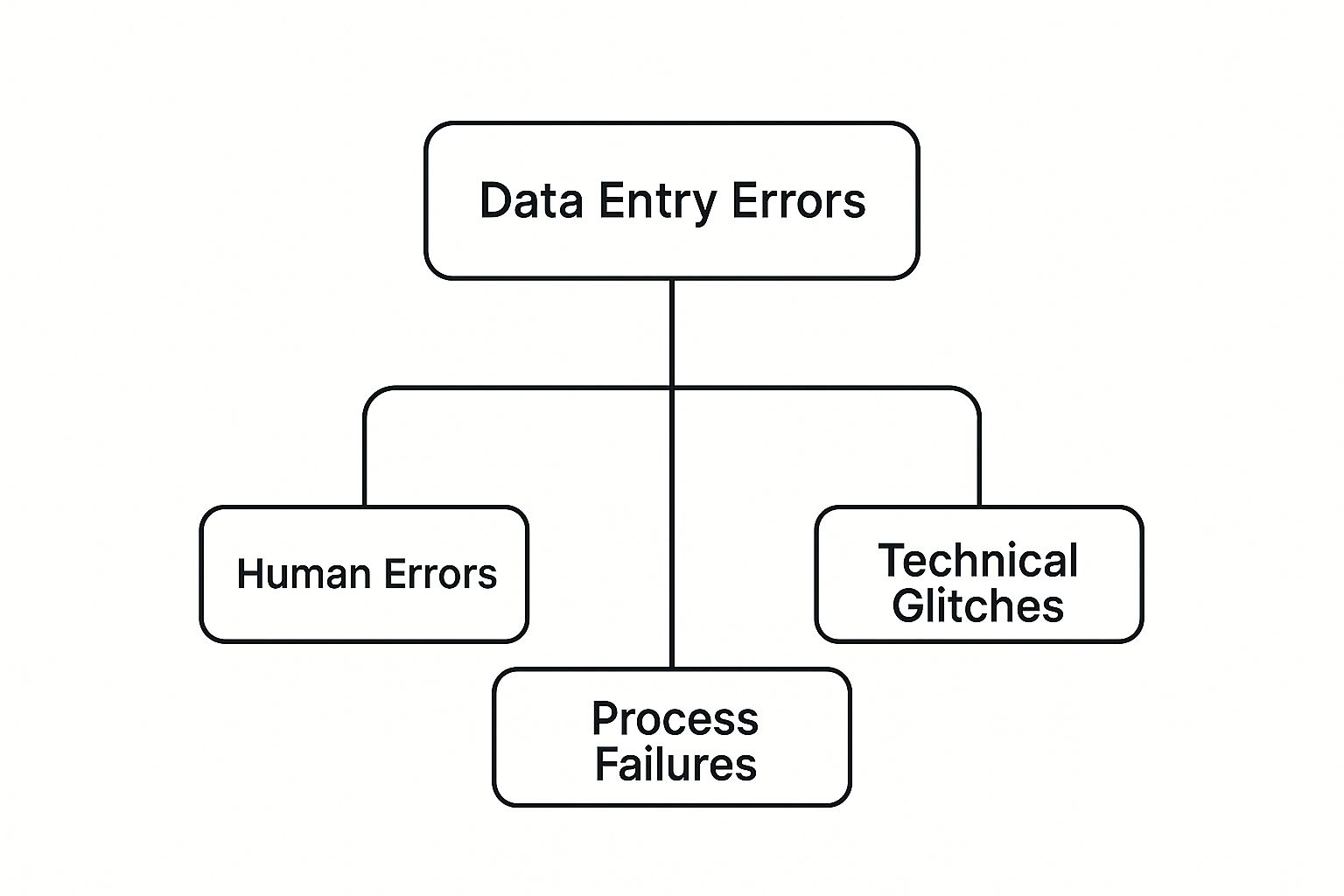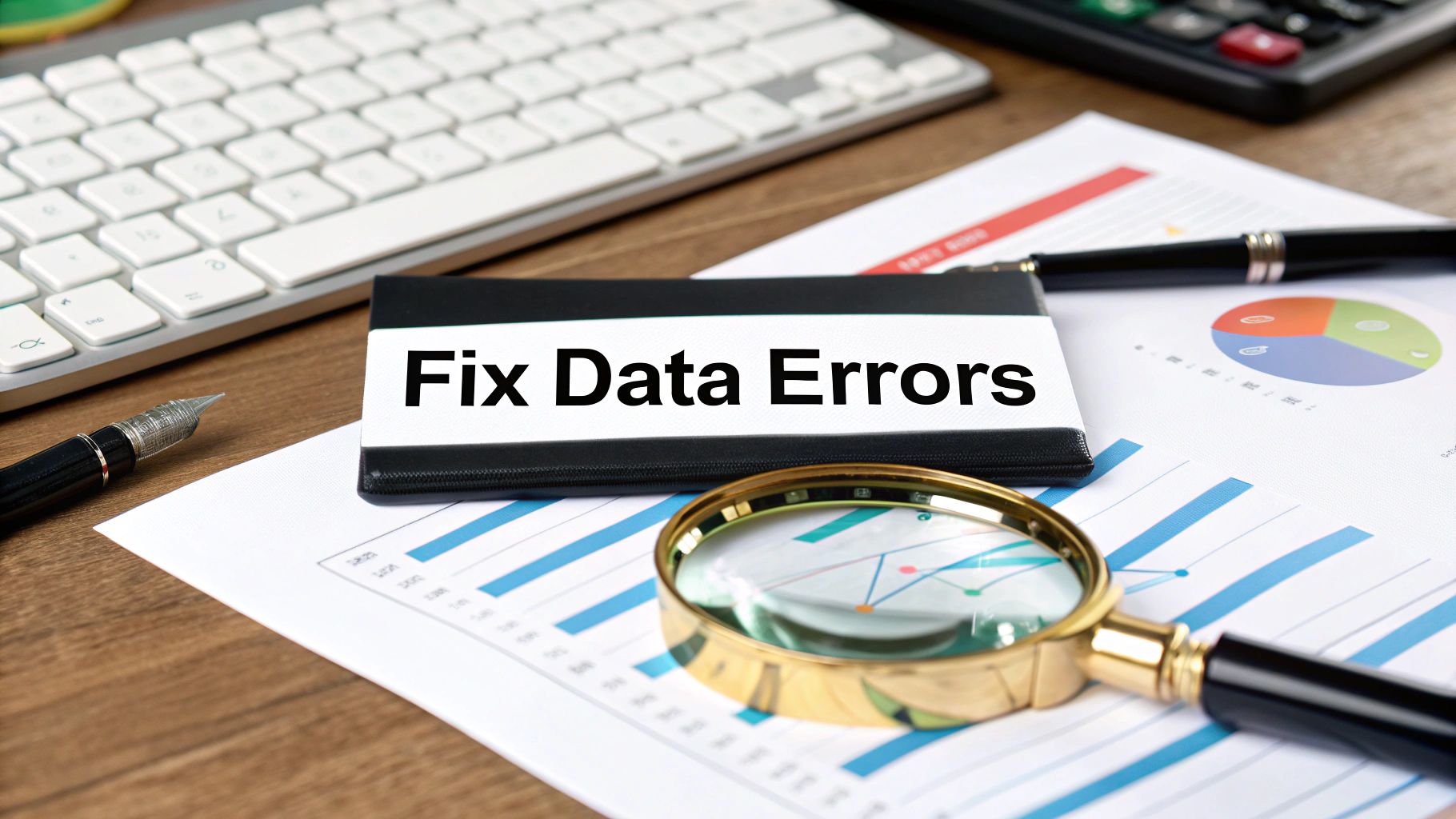Fixing Data Entry Errors Before They Cost You
It might just be a simple keystroke mistake, but don't be fooled. That seemingly harmless typo is a serious business threat hiding in plain sight. These tiny data entry errors aren't just small slip-ups; they're like little cracks forming in your company's foundation.
If you ignore them, they have a nasty habit of spreading. Before you know it, they can poison financial reports, wreck your strategic decisions, and even damage the trust you've built with your customers. What starts as a minor issue can quickly snowball into a major operational and financial headache.
The True Cost of a Single Keystroke Mistake

It’s easy to shrug off a small data entry error. A wrong digit in a sales report, a misspelled name, an incorrect address—it feels like a quick fix, right? In reality, the damage is far more severe than it looks on the surface.
Think of it like a tiny leak in a ship's hull. One drop is nothing. But over time, enough of those drops will sink the entire vessel. That’s the real danger here. Data entry errors rarely travel alone, and their impact ripples through every system and decision that depends on that information.
The real cost isn't just the few seconds it takes to correct one typo. It's the compounding damage that quietly spreads throughout your entire organization.
The Financial Drain of Flawed Data
The most obvious hit comes straight to your wallet. A misplaced decimal in an invoice? You’re now over-billing or under-billing, messing directly with your cash flow. An incorrect inventory count can lead to stockouts (and lost sales) or overstocking (and wasted money).
Research shows the average error rate for manual data entry is about 1%. That sounds deceptively low until you think about what it means at scale.
For every 10,000 manual entries, you can bet there are around 100 errors lurking in there. Each one carries a hidden price tag, from the labor needed to hunt it down and fix it to the bad business decisions made because of it.
The Operational Friction Caused by Inaccuracy
Beyond the direct financial hit, bad data gums up your entire operation. It forces your team to waste precious time doing "data janitor" work—manually chasing down and fixing mistakes instead of focusing on what they were actually hired to do.
This leads to a few painful outcomes:
- Wasted Labor: Your best people get pulled from high-value strategic tasks to do boring, repetitive data cleanup.
- Corrupted Analytics: Your marketing campaigns start targeting the wrong people, and your sales forecasts are built on a foundation of sand.
- Damaged Customer Relationships: Shipping orders to the wrong address or sending emails with misspelled names is a fast way to kill customer trust and loyalty.
When it comes down to it, data entry errors are far more than just clerical mistakes. They are a systemic threat that kills efficiency, compromises your data's integrity, and puts the brakes on growth. Understanding their true impact is the first step toward building the kind of accurate, reliable data culture your business needs to survive and thrive.
Spotting the 7 Most Common Data Entry Errors
To get rid of data entry errors for good, you first have to know what you’re up against. These aren't all the same kind of mistake. They come in different flavors, each with its own cause and its own way of wrecking your data. Learning to spot them is the first real step toward building a business on solid, reliable information.
Think of yourself as a detective. You can't solve the case until you know what kind of clues you're looking at. In the world of data, the "clue" is the error itself. Figuring out its type—a typo, a missing field, a formatting mess—points you right to the culprit, whether it's a simple human slip-up, a system glitch, or a broken process.
Let's break down the usual suspects. Here are the most common types of data entry errors, with real-world examples to help you see them in your own systems.
This infographic gives a great overview, showing that errors fall into three main buckets.

As you can see, while it’s easy to point fingers at the person typing, the problem is often bigger. It’s baked into the systems we use and the rules we follow (or don't).
Human and Typographical Errors
This is the classic, most well-known category. These mistakes happen during manual data input, and even your most meticulous employee is bound to make one when dealing with huge amounts of information.
- Typos (Misspelling Errors): These are simple keyboard fumbles. Think typing "Jhon" instead of "John" or "Maimi" instead of "Miami." They seem small, but they’re big enough to make a customer record impossible to find or cause an important email to bounce.
- Transposition Errors: This one is sneaky. It’s when two numbers or letters right next to each other get swapped. For instance, a birth year entered as 1987 instead of 1978, or an address like 341 Main St instead of 143 Main St. They are notoriously hard to catch with a quick glance.
- Omission Errors: This is when data gets left out completely. Maybe a new customer is added, but the phone number field stays blank. Without that key piece of info, the entire record might be useless for sales follow-ups or support calls.
- Commission Errors: The exact opposite of omission—this is when extra, incorrect data gets added. A classic example is adding an extra number to a zip code (902105 instead of 90210), which guarantees a shipping failure.
Research shows that manual data entry has an average error rate of about 1%. That sounds tiny, right? But it means for every 1,000 records your team enters, about 10 of them are wrong. That creates a quiet but constant drag on your operations and your bottom line.
Formatting and Inconsistency Errors
These errors aren't about the information being factually wrong, but about it being entered in the wrong way. They create chaos in your database by having multiple versions of the same truth, making it a nightmare for software to analyze anything correctly.
For instance, if one person enters "CA," another types "Calif.," and a third writes out "California" in the same customer database, you can't get an accurate count of customers from that state without a massive cleanup project.
A few common examples include:
- Inconsistent Capitalization: Entering "acme inc." in one place and "Acme Inc." in another.
- Varying Formats: Using "St." for one address and "Street" for another, or mixing up date formats like "05-12-2024" vs. "May 12, 2024."
- Incorrect Data Type: This happens when text is put into a number-only field (or vice versa), which can cause your software to crash or produce garbage reports.
To help you connect the dots, this table summarizes the most frequent errors, their causes, and where they tend to cause the most pain in a business.
Common Data Entry Errors and Their Primary Causes
| Error Type | Common Cause | Most Impacted Area |
|---|---|---|
| Typos & Transposition | Human fatigue, lack of focus, fast typing | Customer Service, Marketing |
| Omission & Commission | Distractions, unclear source documents | Sales, Logistics, Finance |
| Formatting Errors | Lack of standardized data entry rules | Data Analytics, Reporting |
| Inconsistency Errors | Multiple users with different habits | CRM Management, Operations |
In the end, figuring out which of these data entry errors is showing up most often in your business is the crucial first step. It lets you stop just fixing individual mistakes and start tackling the root cause—whether that means better training, clearer rules, or adopting smarter tools to prevent them from ever happening again.
How Inaccurate Data Silently Damages Your Business

It’s easy to dismiss data entry errors as small, harmless typos. A minor slip-up here, a misplaced number there—what's the big deal? But in reality, these "small" mistakes act like a slow-acting poison, seeping into every part of your business and quietly corrupting your ability to make smart decisions.
If data is the lifeblood of your company, then every single error contaminates the stream. It’s not just a messy spreadsheet; it's a ripple effect that can seriously damage your finances, customer trust, and day-to-day operations. Let's break down exactly where the pain hits hardest.
The Financial Fallout from Flawed Figures
The most immediate and painful hit is to your bottom line. A single misplaced decimal on an invoice can mean overcharging a loyal customer or, even worse, under-billing for your hard work and torpedoing your revenue.
Think about a sales report where a product's price is logged as $19.99 instead of the correct $199.90. Suddenly, your entire forecast for that product is built on a lie. This single mistake triggers a cascade of problems.
- Inaccurate Financial Reporting: Your P&L statements become unreliable, giving you a false sense of security or creating panic over nothing.
- Budgeting Chaos: How can you plan for the future when your past data is wrong? You might pour money into a failing project or starve a winning one.
- Compliance Risks: In many industries, bad financial records aren't just an internal problem—they're a legal liability that can lead to massive fines and painful audits.
Essentially, these errors create a foundation of financial quicksand. You can't make solid strategic moves when the ground beneath you is constantly shifting.
Damaged Customer Relationships and Wasted Marketing Spend
Your customer data is pure gold, but simple errors can turn it into a liability overnight. A misspelled name or a wrong email address means your "personalized" marketing campaigns feel completely impersonal—or never even show up.
Put yourself in the customer's shoes. How do you feel when a package arrives at the wrong address? Or when you get an email addressed to "Jhon" instead of "John"? It makes your brand look sloppy and unprofessional, instantly eroding trust.
This is where having a tight system for your customer info is non-negotiable. To see how a structured approach stops these embarrassing mistakes, check out our guide on the fundamentals of customer relationship management basics.
Poor data quality is a direct attack on your marketing ROI. It’s estimated that businesses waste a staggering 21% of their marketing budget on campaigns fueled by bad data, essentially throwing money away by sending great messages to the wrong people.
Crippled Operations and Supply Chain Breakdowns
Beyond the numbers and marketing messages, your day-to-day operations take a massive hit from bad data. If your inventory system says you have 50 units of a product but you actually only have 5, you're going to sell things you can't ship. Cue the angry customers, frantic support calls, and a reputation for being unreliable.
Incorrect data can bring your entire supply chain to a screeching halt. A wrong supplier address, an incorrect part number, or a flawed inventory count creates bottlenecks that stop production and delay deliveries. Every error forces your team to stop doing productive work and start playing detective, wasting time and killing morale.
The Overlooked Security Threat
Here’s the consequence that most people miss: security. We spend so much time worrying about hackers from the outside, but internal mistakes can leave the front door wide open. Human error is a huge driver of data breaches, and it can be as simple as an employee accidentally typing the wrong email address and sending sensitive files to a complete stranger.
This isn't just a hypothetical scenario. Research shows human error plays a role in 68% of all data breaches. Even more alarmingly, in 2024, internal mistakes were responsible for 35% of breaches, a huge jump from the year before. This shows that data entry errors aren't just an operational headache—they are a serious and growing security risk.
Why Manual Data Entry Is a Losing Battle
Relying on your team to manually key in business data is like asking someone to hand-copy a library of books in the age of the printing press. Sure, the dedication is admirable, but the process itself is fundamentally broken. It's a fight against volume, speed, and complexity that people were never meant to tackle alone.
Even your most careful, dedicated employee is going to make data entry errors. It’s not a question of skill or how much they care; it’s a simple matter of human limitation.
Fatigue kicks in after hours of staring at a screen. Distractions are everywhere in a busy office. And the sheer monotony of the work makes it nearly impossible to maintain perfect focus. Each of these creates a tiny opening for a mistake—a transposed number, a misspelled name, or a missed field—to slip right through.
The Unavoidable Human Error Rate
Let's be real: manual data entry is inherently flawed. Study after study shows that manual processes have an average error rate of around 1%. That might sound small, but its impact blows up when you scale it across thousands of records.
For every 10,000 pieces of information your team enters, you can bet around 100 errors are hiding in your systems. In fields where precision is everything, like medical records or complex financial data, that rate can climb even higher, making the consequences that much worse.
The bottom line is you can train your team, create checklists, and preach about focus, but you can never completely stamp out the natural human tendency to make occasional mistakes.
Trying to get perfect data accuracy through manual effort alone is like trying to hold back the tide with a bucket. You might feel like you're making progress, but you’re ultimately fighting a force of nature you can't beat.
Scaling Up the Problem, Not the Solution
This is where the problem gets exponentially worse: as your business grows, so do the errors. More customers mean more invoices. More products mean more inventory records. More marketing campaigns mean more leads to process.
Hiring more people to handle the load doesn't fix the core issue—it just scales the problem right along with your business.
Think about a small business processing 50 invoices a day. A 1% error rate means they might have one or two bad invoices a week. It's annoying but manageable. Now, imagine that business grows and starts processing 500 invoices a day. All of a sudden, they're dealing with five errors every single day. The team ends up spending more time fixing mistakes than doing productive work, and that operational drag becomes a serious roadblock to growth.
The challenges are painfully clear in processes like supplier onboarding. This is a perfect example of where specialized supplier onboarding software can step in to eliminate endless manual keying and the errors that come with it.
Automation Isn't a Choice—It's a Necessity
Framing this as a battle between humans and technology completely misses the point. The goal isn’t to replace people. It's to empower them by automating the very tasks that humans are poorly suited to do in the first place.
Automation isn't just an "efficiency hack" to save a few minutes. It's a strategic must-have for achieving the kind of data integrity modern businesses need to even compete, let alone win.
When you offload the repetitive, mind-numbing task of data input to a machine, you free up your team to focus on what they do best:
- Analyzing the data to find real growth opportunities.
- Building relationships with customers and partners.
- Solving complex problems that require actual brainpower.
Automated systems don't get tired, they don't get distracted, and they follow the rules with perfect consistency, every time. Shifting from manual input to automated workflows is the only sustainable way to win the battle against data entry errors and build a reliable foundation for your business's future.
How Modern Tools Eliminate Data Entry Errors

Fighting data entry errors by asking people to "be more careful" is a losing battle. It's like trying to bail out a boat with a thimble. Instead of fighting against human nature, what if we just bypassed the problem entirely?
That's where modern technology comes in. These tools aren’t just a slight improvement; they’re a complete game-changer, fundamentally shifting how businesses achieve data accuracy. They handle the repetitive, detail-heavy work that humans are simply not built for, and they do it with perfect consistency, speed, and precision.
Let’s dive into the tech that’s making manual data entry obsolete.
Optical Character Recognition (OCR): The Digital Translator
Imagine you have a stack of 1,000 paper invoices. The old way meant someone had to manually type every single line item, vendor name, and due date into a spreadsheet. It’s tedious, mind-numbing work—and a perfect recipe for errors.
This is where Optical Character Recognition (OCR) technology shines.
Think of OCR as a universal translator for documents. It scans physical or digital files—like PDFs, photos of receipts, or scanned contracts—and "reads" the text, converting it into structured, machine-ready data. Suddenly, that stack of invoices is automatically digitized and loaded into your system.
- Problem It Solves: Manual transcription from paper or image-based documents.
- Practical Application: A law firm uses OCR to digitize mountains of old case files. What was once locked away in filing cabinets is now fully searchable and accessible in seconds.
Just like that, one of the biggest sources of data entry errors—transferring info from one format to another—is virtually eliminated.
Robotic Process Automation (RPA): The Digital Workforce
If OCR is the translator, then Robotic Process Automation (RPA) is the doer. RPA uses software "bots" programmed to perform repetitive, rule-based tasks across different apps, just like a person would—only faster and without ever making a mistake.
For example, you can program an RPA bot to open an email, download an attached invoice, use OCR to pull the data, enter that information into your accounting software, and then archive the original email. It can do this workflow flawlessly, 24/7, without ever needing a coffee break.
By automating these high-volume, predictable tasks, RPA frees up your team to focus on what humans do best: strategic thinking, customer relationships, and creative problem-solving.
These bots are the key to creating seamless, automated workflows. For companies trying to maximize their digital campaigns, combining RPA with other tools is a core tenet of effective marketing automation. You can learn more in our detailed guide on marketing automation best practices.
AI-Powered Validation: The Smart Gatekeeper
Artificial Intelligence takes things a step further by adding a layer of genuine intelligence. Older systems might just check if a zip code field has five numbers. An AI-powered system, on the other hand, can do much more.
AI validates information against massive databases in real time.
When a new customer address is entered, for instance, AI can instantly cross-reference it with postal service records to fix typos or suggest the standardized format. It can also spot a likely duplicate entry by recognizing that "John Smith" at 123 Main St. is almost certainly the same person as "J. Smith" at 123 Main Street.
One of the most powerful tools in this arena is speech-to-text technology, which converts spoken words directly into text, drastically cutting down on manual keystroke errors from audio transcriptions.
The Staggering Difference in Accuracy
The most compelling argument for these tools isn't just theory; it's in the numbers. The gap between human and machine accuracy isn't small—it's a chasm.
Automated systems consistently achieve accuracy rates between 99.959% and 99.99%. To put that into perspective, for every 10,000 entries, an automated system will make only 1 to 4.1 errors.
How does that compare to a human? A skilled data entry operator will commit around 100 to 400 errors for the same volume. That’s a difference of up to 100 times.
This level of precision changes everything. It means you can actually trust your financial reports, rely on your customer data, and build business strategies on a foundation of near-perfect information. Adopting modern tools isn’t just about stopping data entry errors; it's about unlocking a new level of reliability for your entire organization.
Building a Culture of Data Accuracy
While powerful software is a huge leap forward, technology alone can’t shield you from data entry errors. The real, long-term fix isn't just a tool—it's a mindset. To truly safeguard your data, you need to build a company culture where accuracy is everyone’s job, not just a task for the IT or admin team.
Think of it like this: you can hire one lifeguard to watch a crowded beach, or you can teach everyone how to swim. The second option is far more effective. When your whole team values and actively contributes to data quality, your business becomes stronger and more reliable from the ground up.
Establishing Clear Data Standards
The bedrock of an accuracy-first culture? Consistency. Without clear, simple rules, every employee will enter information based on their own habits, quickly turning your systems into a chaotic mess.
This is why creating straightforward data standards is non-negotiable. It means defining universal formats for common entries. For instance, all dates must follow a "YYYY-MM-DD" format, state names must be the two-letter abbreviation ("CA," not "Calif."), and customer names must use a specific capitalization rule. These standards eliminate guesswork and ensure everything stays uniform.
A proactive culture focused on data quality does more than just prevent errors; it directly boosts efficiency and productivity. By getting data right the first time, teams can stop wasting cycles on cleanup and focus on high-value work. This approach is essential for anyone looking to improve sales productivity and drive meaningful growth.
Implementing Proactive Processes
Once you have standards, the next step is to weave them into your daily workflows. Think of these processes as guardrails, catching mistakes before they ever have a chance to pollute your database.
Here are a few powerful habits to build:
- Double-Entry Verification: For critical info like financial figures or client contact details, have one person enter it and a second person verify it. It’s a simple step that dramatically cuts down on single-keystroke errors.
- Continuous Team Training: Standards only work if people know them. Hold regular, brief training sessions to keep everyone aligned and reinforce why accuracy matters in their specific roles.
- Routine Data Audits: Don't wait for problems to appear. Schedule regular checks to scan your databases for duplicates, formatting errors, and other inconsistencies. This helps you spot and fix issues early.
For a deeper dive, exploring proven strategies for efficiency and error reduction can offer more great ideas. Ultimately, fostering this kind of culture transforms your data from a potential liability into your most trustworthy strategic asset.
Got questions about data accuracy? You’re not alone. When you start thinking about moving away from manual data entry, a lot of practical questions pop up. What’s the first step? Is this going to be expensive? What does it mean for my team?
Let's cut through the noise. Here are the straight answers to the most common questions we hear from businesses getting serious about clean data.
What Is the First Step to Reduce Data Entry Errors?
Before you do anything else, you need to run a data quality audit. Think of it like a diagnosis. You wouldn't take medicine without knowing what’s wrong, and you can’t fix your data problems until you know exactly what they are.
Start digging into your current databases. Look for patterns. Are you seeing a lot of simple typos? Duplicate customer records? Or are fields just being left blank? Find out which processes or teams are creating the most errors. This gives you a clear baseline so you can focus your efforts where they’ll make the biggest impact.
Is Automated Data Entry Software Too Expensive?
It's easy to look at the price tag of automation software and hesitate. But what about the hidden costs you're already paying? Bad data quietly bleeds money from your business through wasted staff time, poor decisions based on flawed reports, and missed sales opportunities.
Honestly, the return on investment (ROI) from automation usually happens much faster than people think. Modern software-as-a-service (SaaS) tools have made automation affordable for businesses of all sizes. The question isn't "Can we afford this?" It's "Can we afford to keep doing things the old way?"
Automation is set to transform, not eliminate, data-focused roles. As repetitive input becomes automated, the value of human oversight will grow.
The future isn’t about replacing people; it's about upgrading their roles. Instead of mind-numbing data entry, your team will manage the automated systems, handle the tricky exceptions AI can't, and analyze the high-quality data you’re collecting. They’ll move from data entry clerks to data stewards—a far more valuable role for everyone.
Stop wasting time on manual downloads and start acting on leads instantly. LeadSavvy Pro automates the entire process, sending your Facebook leads directly to where you need them. Try our free plan today and see the difference.







